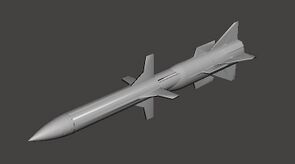OCE-1 Chaos: Difference between revisions
ContraViper (talk | contribs) No edit summary |
ContraViper (talk | contribs) No edit summary |
||
| Line 10: | Line 10: | ||
{{flagicon|Inyursta}} [[Inyurstan Navy]]<br /> | {{flagicon|Inyursta}} [[Inyurstan Navy]]<br /> | ||
|wars= | |wars= | ||
|designer= | |designer= Martel Arms | ||
|design_date= 1995 | |design_date= 1995 | ||
|manufacturer= | |manufacturer= Martel Arms | ||
|unit_cost= | |unit_cost= | ||
|propellant= Solid fuel | |propellant= Solid fuel | ||
| Line 19: | Line 19: | ||
|engine= | |engine= | ||
|engine_power= | |engine_power= | ||
|weight= 600 kg (1,320 lb) | |weight= 600 kg (1,320 lb) - 694kg (1,530lb) | ||
|length= 3.8 metres (12.5 ft) | |length= 3.8 metres (12.5 ft) - 4.6m (16.1ft) | ||
|height= | |height= | ||
|diameter= | |diameter= | ||
| Line 37: | Line 37: | ||
|guidance= Passive Radar, with GPS/DSMAC guidance (Block III & Block IV) and Electro-Optical active (Block III & Block IV). | |guidance= Passive Radar, with GPS/DSMAC guidance (Block III & Block IV) and Electro-Optical active (Block III & Block IV). | ||
}} | }} | ||
The '''OCE-1 Chaos''' ('''O'''rdinance '''C'''ontre- '''E'''mision) is an anti-radiation missile (ARM) in | The '''OCE-1 Chaos''' ('''O'''rdinance '''C'''ontre- '''E'''mision) is an anti-radiation missile (ARM) in widespread use with the Inyurstan Armed Forces. Finding use in multiple branches of service, it can be launched from aircraft, ground launchers and ships. Secondary targets include small warships and certain aircraft. | ||
==History== | |||
Following the [[1986 Guerroca War]], wherein North Guerrocan forces were able to deplete existing Inyurstan stockpiles of foreign-supplied anti-radiation missiles, the Inyurstan military realized the need for an indigenously-produced, readily available weapon to target enemy surface-to-air missiles (SAMs). An open contract was placed between competing firms, open to both indigenous designs and Inyurstan-based production of foreign missiles. However, due to the political climate of the late 1980's and early 1990's - mainly the easing of tensions with formerly hostile [[Gran Cuscatlan]], an increase in cartel violence & renewed [[Marcon de Rouge]] offensive, and budget strains - the program was caught in "development hell". | |||
In 1995, the program resumed and a then-simplistic design by [[Martel Arms]] was adopted. The missile, dubbed OCE-1, was a 3.8m long missile with a passive-radar homing warhead. It was adopted for service on Inyursta's aging A-4 and F-5 fleet. When the (amerifighter)... | |||
During the [[Lolloh-Ruolnik Conflict]], the missile would see prolific combat as the [[Inyurstan Air Force]] frequently engaged in repeated games of cat-and-mouse with the air defenses of the Lollohian Army. During this time, several lessons would be learned. | |||
The first of which was the need for incorporation of alternate guidance, mainly stationary guidance such as GPS and DSMAC units which would | |||
==Variants== | ==Variants== | ||
Revision as of 11:52, 26 January 2022
| OCE-1 Chaos | |
|---|---|
Chaos Block IV Standard | |
| Type | Anti-Radiation Missile |
| Place of origin | |
| Service history | |
| In service | 1998–present |
| Used by | |
| Production history | |
| Designer | Martel Arms |
| Designed | 1995 |
| Manufacturer | Martel Arms |
| Produced | 1997–present |
| Specifications | |
| Weight | 600 kg (1,320 lb) - 694kg (1,530lb) |
| Length | 3.8 metres (12.5 ft) - 4.6m (16.1ft) |
| Blast yield | 15 kg Tandem HEAT |
| Propellant | Solid fuel |
Operational range | 40km (Block I) 30-100km (Block II & Block III) |
| Speed | Mach 2.1 - Mach 3 |
Guidance system | Passive Radar, with GPS/DSMAC guidance (Block III & Block IV) and Electro-Optical active (Block III & Block IV). |
| Accuracy | 5m CEP |
The OCE-1 Chaos (Ordinance Contre- Emision) is an anti-radiation missile (ARM) in widespread use with the Inyurstan Armed Forces. Finding use in multiple branches of service, it can be launched from aircraft, ground launchers and ships. Secondary targets include small warships and certain aircraft.
History
Following the 1986 Guerroca War, wherein North Guerrocan forces were able to deplete existing Inyurstan stockpiles of foreign-supplied anti-radiation missiles, the Inyurstan military realized the need for an indigenously-produced, readily available weapon to target enemy surface-to-air missiles (SAMs). An open contract was placed between competing firms, open to both indigenous designs and Inyurstan-based production of foreign missiles. However, due to the political climate of the late 1980's and early 1990's - mainly the easing of tensions with formerly hostile Gran Cuscatlan, an increase in cartel violence & renewed Marcon de Rouge offensive, and budget strains - the program was caught in "development hell".
In 1995, the program resumed and a then-simplistic design by Martel Arms was adopted. The missile, dubbed OCE-1, was a 3.8m long missile with a passive-radar homing warhead. It was adopted for service on Inyursta's aging A-4 and F-5 fleet. When the (amerifighter)...
During the Lolloh-Ruolnik Conflict, the missile would see prolific combat as the Inyurstan Air Force frequently engaged in repeated games of cat-and-mouse with the air defenses of the Lollohian Army. During this time, several lessons would be learned. The first of which was the need for incorporation of alternate guidance, mainly stationary guidance such as GPS and DSMAC units which would
Variants
- OCE-1 (Block I): ...
- OCE-1A: ...
- OCE-1B (Block II): Upgraded model produced starting in 2010. Features an estimated 20-30% increase in range, plus improved electro-optical seeker component.
- OCE-1B-S: Ground or ship-launched version used by the Inyurstan Army & Inyurstan Navy. Approximate range 30km due to the energy loss of surface-launch
- OCE-1C: ...
- OCE-1F (Block III):
- OCE-1E:...
- OCE-1E-S:...
- OCE-1L (Block IV):...
- OCE-1L-S:...
- OCE-1M (Block IV+):...
Compatible Platforms
Fixed Wing Jet:
Fixed Wing Propellor:
Helicopter:
UCAV
